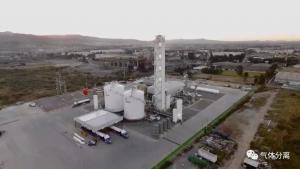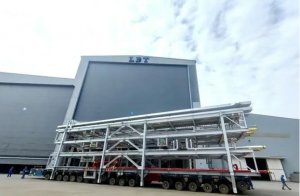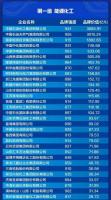谢巴机场跑道改造荣获国际杰出项目奖

谢巴被高耸的沙丘环抱。
中国水电集团公司参与项目建设。
10月20日,在项目管理协会主办的一次视频会议上,沙特阿美的谢巴机场跑道改造项目荣获2020年欧洲、中东和非洲杰出项目奖。
该公司采用创新性建筑技术,展现出高效且有效的领导能力,在77天内(比计划提前4个月)安全无事故地完成具有挑战性的项目。
石油设施项目部经理艾哈迈德·阿莱迪(Ahmed O. Aredhi)表示:“这项成就超出所有预期,提前完工是由强大的物流计划、技术应用以及所有利益相关者不懈努力、以期尽快交付项目所付出的巨大努力所共同促成。”
该项目由沙特阿美项目管理团队牵头,项目建设得益于数位专业人员的专业知识和奉献精神,这些专业人员来自沙特阿美航空部、运输和设备服务部、项目检验部和咨询服务部门等多个部门。
该团队还得到了其他几个部门和关联机构的全力支持,包括阿美海外公司、谢巴生产部、材料及物流部、工业安全部、设施规划部、项目管理办公室部,以及项目承包商中国水电建设集团。

沙特阿美谢巴机场跑道。
跑道和照明改造
在条件艰苦的鲁布·哈利(阿语,意为空旷地带)沙漠中,为谢巴油田服务二十年的10,000英尺跑道需要改造,以确保该地区的航空运营安全。
改造项目采用一种节省成本且环保的方法:“碎石化”,即将原有混凝土打碎,作为沥青铺设的基底,然后对饱经风雨的跑道进行铺装。
项目工程师海尔德·马丁斯(Helder Martins)表示:“ 我们没有丢弃混凝土,而是重复利用现有材料,并以三分之一的成本,将跑道的预期寿命提高到30至40年,” 他指出这项技术是继吉达国际机场之后、第二次在沙特境内应用。
这项艰巨的任务需要高超的技术、用时两年半的精心计划,以寻求最佳的翻新解决方案。航空和设施计划部在法赫德国王石油和矿产大学的支持下进行了相关研究。
阿莱迪说:“ 谢巴的环境艰苦而严酷,与周边任一城市都相距遥远。要想快速获取人力、甚至是最微不足道的工具,都需要乘飞机,因此,这不像在胡拜尔或布盖格实施项目那样容易。”
不可或缺的交通枢纽
谢巴跑道最初建于1997年,位于鲁布·哈利沙漠的两个盐滩之间,沙丘与跑道的高差最多达到175米。这条跑道扮演着重要的角色:每天为客户提供数百万桶自然资源、以及使员工和承包商方便地出入谢巴这个庞大的石油基地。
谢巴原油增产项目部负责人内萨尔·哈里发(Nezar H. Khalifah)说:“早期规划是该项目的关键,因为机场是地区的主要连接点,机场的关闭将影响谢巴的所有人员。离谢巴最近的城市是哈萨,距离谢巴有600公里的车程,由于每周有大量的人员通勤和运输需求,因此不建议将哈萨作为替代枢纽。”
最初的计划是保持机场开放、允许飞机降落并在部分跑道上起飞,并分两个阶段进行改造。但是,通过模拟,项目团队识别出与保持机场开放相关的数个安全风险,于是最终决定关闭机场,并将所有流量转移到150公里以外的、距谢巴最近的政府机场。这带来了新的挑战,因为去往该政府机场,需要在双向道路上驱车,艰难跋涉90分钟后方可到达。

谢巴设施所用管道。
安全第一
尽管面临挑战和困难,但仍有40,000名人员成功安全地乘坐大巴往返于谢巴,大巴车队在三个月内合计出行约1,800次。
马丁斯说:“为了提高机场之间道路的安全性,航空和运输部门翻修了部分人行道,并为紧急停车设置路肩。我们还引入第三方交通控制,来监控我们车辆的道路安全。”
团队提前完成项目建设。
马丁斯说:“虽然该项目提前加速建成,并且全天候不间断地有人员和设备在工作,但是项目施工仍然以零事故、零未遂事件的安全记录得以完成。”
谢巴油田位于偏远的鲁卜·哈利(阿语,意为空旷地带),这里人迹罕至,是世界上环境最恶劣、最荒凉的地区。然而,同时,谢巴屡获殊荣,具有规划和满足全球能源需求的能力。
Shaybah airstrip upgrade receives international excellence award

Shaybah surrounded by the towering sand dunes.
China’s Sinohydro Corporation among the Project’s team
On Oct. 20, Aramco’s Shaybah airstrip upgrade project received the 2020 Project Excellence Award for Europe, Middle East and Africa during a virtual meeting hosted by the Project Management Institute.
The company deployed innovative construction technologies and demonstrated high efficiency and effective leadership, completing the challenging project in 77 days — 4 months ahead of schedule — and with zero incidents.
“This is an achievement that exceeded all expectations,” said Ahmed O. Aredhi, Oil Facilities Projects Department manager. “The early completion was driven by robust logistic planning, technology utilization, and remarkable collaborative effort from all stakeholders working tirelessly to deliver the project in the shortest time possible.”
Led by Aramco’s Project Management team, the project demanded the expertise and dedication of several Aramco entities and professionals, including Aviation, Transportation and Equipment Services, Project Inspection, and Consulting Services departments.
The team was also fully supported by several additional departments and affiliates, including Aramco Overseas Company, Shaybah Producing, Materials and Logistics, Industrial Security, Facilities Planning, Project Management Office Department and of course, the company’s contractor, Sinohydro Corporation.
Aramco’s Shaybah airstrip.
Upgrading runway and lighting
After two decades of service in the harsh and unyielding desert of the Rub’ al-Khali (The Empty Quarter), the 10,000 foot runway serving Shaybah oil field was in need of an upgrade to maintain the safety of aviation operations at the field.
The restoration project included resurfacing the battered runway using a cost saving and environmentally friendly method called “rubblization,” where the existing concrete is broken up and used as a base for asphalting.
“Instead of disposing of the concrete, we reused the existing material and increased the life expectancy of the runway to 30-40 years at a third of the cost,” said project engineer Helder Martins, noting that this was only the second application of rubblization in the Kingdom after the Jiddah International Airport.
This giant undertaking required a vast array of skill sets and took two and a half years of meticulous planning, including studies conducted by Aviation and the Facilities Planning Department with the support of King Fahd University of Petroleum and Minerals to reach the best possible solutions for the refurbishment.
“Shaybah is a difficult and harsh environment to work in and geographically very far from any nearby city,” said Aredhi. “To get manpower promptly or even the smallest tool would require an airline trip, so it’s not as easy as doing operations in a city like al-Khobar or Abqaiq.”
Indispensable transportation hub
The Shaybah airstrip was originally constructed in 1997 between two salt flats amid a sea of sand dunes rising up to 175 meters above the runway in the vastness of the Rub’ al-Khali desert. This runway plays a critical role in delivering millions of barrels of natural resources every day to customers as well as conveniently transporting employees and contractors to and from the enormous oil base.
“Early planning was key for this project because the airport is the main connection point for that area and its closure would impact the entire population of Shaybah,” said Nezar H. Khalifah, head of the Shaybah Crude Increment Projects Division. “The nearest city to Shaybah is al Hasa, a 600 km drive, which was not recommended as an alternative hub, due to the huge volumes of personnel and weekly transportation requirements.”
The initial plan was to keep the airport open and allow planes to land and take off on part of the runway, upgrading in two phases. However, the team identified through simulations several safety risks associated with keeping the airport open and a decision was made to shut it down and divert all traffic to the nearest government airstrip 150 km away. This created a new challenge as that strip could only be reached on a difficult 90-minute drive through a two-way road.

Shaybah Pipelines.
Safety above all
Despite the challenges and difficult landscape, 40,000 personnel commuted successfully and safely from and to Shaybah on fleets of buses that are estimated to have taken 1,800 trips in three months to complete the project.
“To increase the safety and security of the road between the airports, the Aviation and Transportation departments renovated some of the pavement and created shoulders for emergency stops,” said Martins. “We also brought a third-party traffic control to monitor the safety of the road for our vehicles.”
The team completed the project ahead of schedule.
“Even with the accelerated nature of this project with continuous labor and machinery working around the clock, the construction activities were completed safely, with zero incidents or near misses,” said Martins.
Shaybah oil field lies in the remote Rub’ al-Khali (The Empty Quarter), which is the most inaccessible area that have the harshest, most desolate environments in the world. Shaybah is a prize-winning example of the ability to plan for and meet global energy demand.





